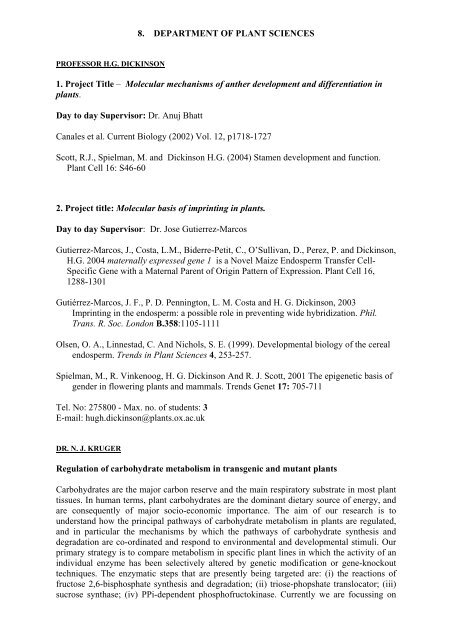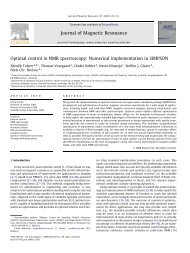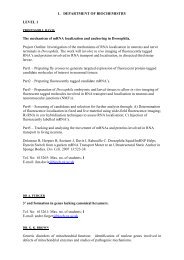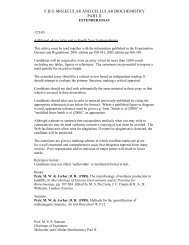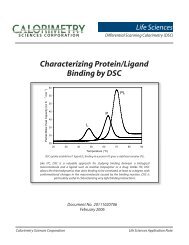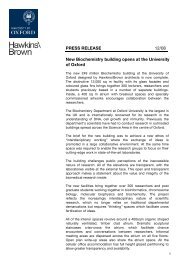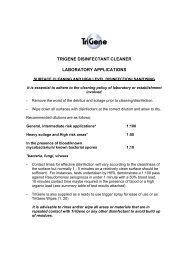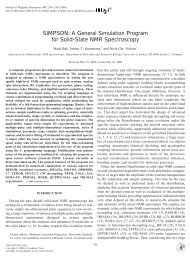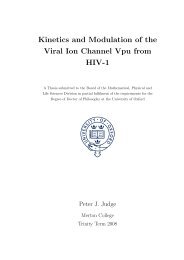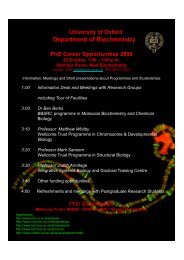8. DEPARTMENT OF PLANT SCIENCES 1. Project Title – Molecular ...
8. DEPARTMENT OF PLANT SCIENCES 1. Project Title – Molecular ...
8. DEPARTMENT OF PLANT SCIENCES 1. Project Title – Molecular ...
Create successful ePaper yourself
Turn your PDF publications into a flip-book with our unique Google optimized e-Paper software.
<strong>8.</strong> <strong>DEPARTMENT</strong> <strong>OF</strong> <strong>PLANT</strong> <strong>SCIENCES</strong>PR<strong>OF</strong>ESSOR H.G. DICKINSON<strong>1.</strong> <strong>Project</strong> <strong>Title</strong> <strong>–</strong> <strong>Molecular</strong> mechanisms of anther development and differentiation inplants.Day to day Supervisor: Dr. Anuj BhattCanales et al. Current Biology (2002) Vol. 12, p1718-1727Scott, R.J., Spielman, M. and Dickinson H.G. (2004) Stamen development and function.Plant Cell 16: S46-602. <strong>Project</strong> title: <strong>Molecular</strong> basis of imprinting in plants.Day to day Supervisor: Dr. Jose Gutierrez-MarcosGutierrez-Marcos, J., Costa, L.M., Biderre-Petit, C., O’Sullivan, D., Perez, P. and Dickinson,H.G. 2004 maternally expressed gene 1 is a Novel Maize Endosperm Transfer Cell-Specific Gene with a Maternal Parent of Origin Pattern of Expression. Plant Cell 16,1288-1301Gutiérrez-Marcos, J. F., P. D. Pennington, L. M. Costa and H. G. Dickinson, 2003Imprinting in the endosperm: a possible role in preventing wide hybridization. Phil.Trans. R. Soc. London B.358:1105-1111Olsen, O. A., Linnestad, C. And Nichols, S. E. (1999). Developmental biology of the cerealendosperm. Trends in Plant Sciences 4, 253-257.Spielman, M., R. Vinkenoog, H. G. Dickinson And R. J. Scott, 2001 The epigenetic basis ofgender in flowering plants and mammals. Trends Genet 17: 705-711Tel. No: 275800 - Max. no. of students: 3E-mail: hugh.dickinson@plants.ox.ac.ukDR. N. J. KRUGERRegulation of carbohydrate metabolism in transgenic and mutant plantsCarbohydrates are the major carbon reserve and the main respiratory substrate in most planttissues. In human terms, plant carbohydrates are the dominant dietary source of energy, andare consequently of major socio-economic importance. The aim of our research is tounderstand how the principal pathways of carbohydrate metabolism in plants are regulated,and in particular the mechanisms by which the pathways of carbohydrate synthesis anddegradation are co-ordinated and respond to environmental and developmental stimuli. Ourprimary strategy is to compare metabolism in specific plant lines in which the activity of anindividual enzyme has been selectively altered by genetic modification or gene-knockouttechniques. The enzymatic steps that are presently being targeted are: (i) the reactions offructose 2,6-bisphosphate synthesis and degradation; (ii) triose-phopshate translocator; (iii)sucrose synthase; (iv) PPi-dependent phosphofructokinase. Currently we are focussing on
two major questions; one is the metabolic and physiological significance of the widespreadoccurrence of multiple isoforms of enzymes catalysing the reactions of central metabolicpathways (metabolic redundancy), and the other is the determination of system-wide fluxdistribution in complex metabolic networks (“fluxomics”). Details of specific undergraduateresearch projects for 2006 will be posted on the internet (http://users.ox.ac.uk/~dops0023/) atthe beginning of Hilary Term. <strong>Project</strong>s are likely to involve one or more of the following: (i)molecular and metabolic characterisation of gene-knockout Arabidopsis plants; (ii) kineticanalysis of purified recombinant or natural enzymes (iii) metabolic studies using radioactiveisotopes (iv) metabolic network flux analysis using steady-state stable-isotope labellingstrategies based on NMR spectroscopy. Our application of these techniques is illustrated inthe following papers:Fernie, A.R., Roscher, A., Ratcliffe, R.G. and Kruger N.J. (2002) Activation ofpyrophosphate: fructose 6-phosphate 1-phosphotransferase by increased fructose 2,6-bisphosphate stimulates conversion of hexose phosphates to triose phosphates butdoes not influence accumulation of carbohydrates in phosphate-deficient tobaccocells. Physiol. Plant. 114, 172-18<strong>1.</strong>Markham, J.E. and Kruger, N.J. (2002) Kinetic properties of 6-phosphofructo-2-kinase/fructose-2,6-bisphosphatase from spinach leaves. Eur. J. Biochem. 269, 1267-1277.Garlick, A.P., *Moore, C. and Kruger, N.J. (2002) Monitoring flux through the oxidativepentose phosphate pathway using [1- 14 C]gluconate. Planta 216, 265-272.Kruger, N.J., Ratcliffe, R.G. and Roscher, A. (2003) Quantitative approaches for analysingfluxes through plant metabolic networks using NMR and stable isotope labelling.Phytochem Rev. 2, 17-30.Walters, R.G., *Ibrahim, D.G., Horton, P. and Kruger, N.J. (2004) A mutant of Arabidopsisthaliana lacking the triose phosphate/phosphate translocator reveals metabolicregulation of starch breakdown in the light. Plant Physiol. 135, 891-906.Tel No: 275016Max. No. of students: 1Email: nick.kruger@plants.ox.ac.uk*Previous Part 2 studentsDR GAIL M. PRESTONLight perception in plant pathogenic bacteriaThe pair of bacteriophytochromes from Agrobacterium tumefaciens are histidine kinaseswith opposing photobiological properties.Karniol B, Vierstra RD. Proc Natl Acad Sci U S A. 2003 Mar 4; 100(5): 2807-2812Tel No: 275132Max. No. of students: 1Email: gail.preston@plants.ox.ac.ukPR<strong>OF</strong>ESSOR R. G. RATCLIFFENMR analysis of fluxes in plant metabolic networks.R.G. Ratcliffe and Y. Sachar-Hill (2005) Revealing metabolic phenotypes in plants: inputsform NMR analysis. Biological Reviews 80, 27-43R.G. Ratcliffe and Y. Sahcar-Hill (2006) Measuring multiple fluxes through plant metabolic
networks. The Plant Journal 44, in pressTel. No: 275001 - Max. no. of students: 1E-mail: george.ratcliffe@plants.ox.ac.ukDR M. TSIANTOSThe role of homeobox proteins in contolling leaf shape in higher plants.Identification of novel components of homeobox pathways in arabidopsis thaliana.Relevant References:Grigg, S., Canales, C., Hay, A. & Tsiantis, M. (2005). SERRATE integrates shoot meristemfunction and leaf axial patterning in Arabidopsis. Nature, in press.Tsiantis M and Hay A. (2003). Comparative plant development: The time of the leaf? NatureReviews Genetics 4, 170-18<strong>1.</strong>Hay, A., Kaur, H., Phillips, A., Hedden, P., Hake, S. and Tsiantis M. (2002). The gibberellinpathway mediates KNOTTED1-type homeobox function in plants with different body plans.Current Biology, 12, 1557-1565.Tel. No: 275112 - Max. no. of students: 2E-mail: miltos.tsiants@plants.ox.ac.ukDR L. SWEETLOVE (Plant Sciences)The impact of reactive oxygen and nitrogen species on the plantmitochondrial proteomeMittler, R. (2002). Oxidative stress, antioxidants and stress tolerance.Trends Plant Sci 7, 405.Crawford, N.M., and Guo, F.Q. (2005). New insights into nitric oxidemetabolism and regulatory functions. Trends Plant Sci 10, 195-200.Sweetlove, L.J., Heazlewood, J.L., Herald, V., Holtzapffel, R., Day, D.A.,Leaver, C.J., and Millar, A.H. (2002). The impact of oxidative stress onArabidopsis mitochondria. Plant J 32, 891-904.O'Brien, K.M., Dirmeier, R., Engle, M., and Poyton, R.O. (2004).Mitochondrial protein oxidation in yeast mutants lacking Mn or CuZnsuperoxide dismutase: Evidence that MnSOD and CuZnSOD have both unique andoverlapping functions in protecting mitochondrial proteins from oxidativedamage. J Biol ChemLindermayr, C., Saalbach, G., and Durner, J. (2005). Proteomicidentification of s-nitrosylated proteins in Arabidopsis. Plant Physiol 137,921-930.Tel No. 75137: Max No of students: 1E-mail: lee.sweetlove@plants.ox.ac.uk


